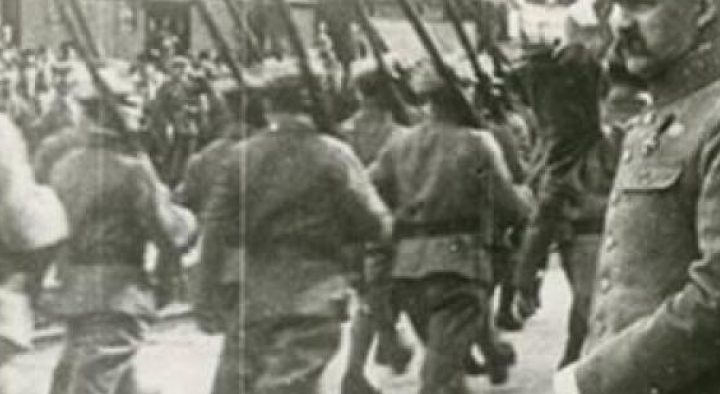Independence defended
Share

“[…] there are no more occupiers. We’re our own masters and hosts,” rejoiced Warsaw politician and columnist Ignacy Baliński in November 1918. But Poland’s newly regained freedom still had to be defended against Russia – just as Ukraine does today.
“Life goes on with astonishing haste. […] Something is happening every hour,” noted Maria Dąbrowska in her Journals (Dzienniki). It was November 10, 1918. In Germany, gripped by revolutionary turmoil, the imperial era was coming to an end. Wilhelm II decided to flee to the Netherlands, and a day later, in French Compiègne, a German delegation signed an armistice, a de facto capitulation that ended the First World War. Austro-Hungary had already crumbled, and civil war was brewing in Russia. New states were being born on the ruins of the former empires. The clock of history struck freedom also for Poland.
To regain independence – that had been the dream of several generations of Poles since their country disappeared from the map of Europe at the end of the 18th century, partitioned among three powerful neighbours: Prussia, Austria and the Russian Empire. There were times, such as during the Napoleonic wars, when the Polish dream of freedom seemed about to come true. Then, however, it slipped away again. Poles had to fight for it time after time: during the Cracow Revolution (1846), the Poznań Uprising (1848) or two anti-Russia revolts: the November Uprising (1830-1831) and the January Uprising (1863-1864). These unsuccessful insurrections came at a high price: death sentences, deportation to Siberia, confiscation of property, an end to Polish autonomy and intensified Germanisation and Russification.
But even in captivity, Polish culture flourished, and people did not turn their backs on Polishness. Outstanding writers, for example, the Nobel Prize winner Henryk Sienkiewicz, or painters, such as Jan Matejko, created with the intent “to lift hearts”. In their works, they evoked the times of Polish greatness and gave people hope.
Independence-focused Poles also pinned their faith on the outbreak of the First World War. In August 1914, the armies of the partitioning powers were pitted against each other: Germany with Austria-Hungary on the one hand and Russia on the other. The prolonged conflict exhausted all three of them. Russia was engulfed by revolutions. The Habsburg Empire had crumbled like a house of cards. Germany – also threatened by revolution – was forced to accept peace on the Triple Entente’s terms. A historic opportunity opened up before the Poles. An action had to be taken, or else it would be lost.
“Disarming German officers everywhere on the streets from the early morning. […] Stripping the Germans of their military assets and seizing civilian authority throughout the day,” we read in Dąbrowska’s Journals. The writer recorded her observations from Warsaw as she went. Notes on the disarming of the Germans were taken on November 11, 1918, in time considered the first day of a reborn Poland. On that cold and foggy Monday, the Regency Council – a body appointed by the occupying German and Austro-Hungarian authorities – ceded power over the army to Józef Piłsudski, a leading Polish independence activist. Three days later, the Council handed full civilian powers over to him.
On November 16, 1918, Piłsudski sent a telegram to the governments of “all belligerent and neutral states”. He informed them that a sovereign Poland had been reborn, encompassing the lands of all the former partitions, and that it was a democratic state built “on order and justice”. The Piłsudski-appointed government of Jędrzej Moraczewski announced important social reforms, such as the eight-hour working day, the right to strike or sickness insurance. Women received voting rights, which was much earlier than in many Western countries. All this made the reviving Poland a thoroughly modern state.
Still, in the autumn of 1918, no one could predict what territorial shape the country would take – or whether it would survive at all. In Galicia, Poles were fighting hard with Ukrainians for Lviv and Przemyśl. The western border of the Polish-Lithuanian Commonwealth was forged in four insurrections against the Germans: the Greater Poland Uprising and three Silesian uprisings. The greatest threat, however, came from the east. Bolshevik Russia wanted to bring its bloody revolution to Europe “over the corpse of White Poland”. In 1920, the Poles beat the Bolsheviks on the outskirts of Warsaw and Lviv, defending their newly regained independence. The Soviet expansion was halted. The Old Continent had almost two decades of peace ahead of it.
But Freedom is not given once and for all. Poland felt it painfully in 1939 when it fell victim to two totalitarian neighbours: Nazi Germany and the Soviet Union. This time it took Poland six years to return to the map of Europe, tragically bloodied and devastated. And it took the country many more decades still to regain sovereignty after the collapse of communism in that part of the world.
Now, a generation of Poles born in the free Polish Republic has entered adulthood. But even in the third decade of the 21st century freedom and peace are not a given in Europe. Russia’s brutal attack on Ukraine has made us all too aware of this.
On November 11, we will once again celebrate Poland’s National Independence Day – happy that we can live in a free homeland but also aware that independence requires constant service. And when necessary, with a gun in hand.
Karol Nawrocki
President of the National Remembrance Institute

The text is simultaneously published in the Polish monthly “Wszystko Co Najważniejsze” as part of a project carried out with the Institute of National Remembrance and the Polish National Foundation.



